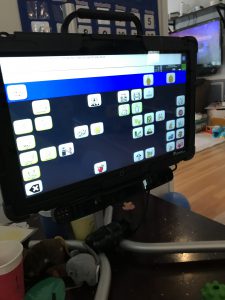 Last fall Joey started using an Augmentative and Alternative Communication (AAC) eye gaze device. But what does augmentative and alternative communication even mean?
Last fall Joey started using an Augmentative and Alternative Communication (AAC) eye gaze device. But what does augmentative and alternative communication even mean?
The AAC page on Wikipedia states, “Augmentative and alternative communication (AAC) is an umbrella term that encompasses the communication methods used to supplement or replace speech or writing for those with impairments in the production or comprehension of spoken or written language. AAC is used by those with a wide range of speech and language impairments, including congenital impairments such as cerebral palsy, intellectual impairment and autism, and acquired conditions such as amyotrophic lateral sclerosis and Parkinson’s disease. AAC can be a permanent addition to a person’s communication or a temporary aid.”
We use AAC with a child when we offer him a picture of goldfish or graham crackers and then ask the child to indicate what he wants for snack by touching the picture. Although the child does not orally express his choice, he is able to communicate with us by touching a picture.
Most often, when people discuss using an AAC device, they are referring to an electronic system that allows the user to select his choices through tapping on a picture or icon. When the desired icon is tapped, the device produces the auditory word.
In recent years, the field of electronic AAC devices has been evolving. The Language Acquisition through Motor Planning (LAMP) Words for Life system has become popular, which is what Joey is using. This system gives the user access to core words, and the students learn to access those words with a “consistent, unique motor pattern paired with auditory feedback”. The words remain in the same place on the board so that the user can built up muscle memory of how he selected the icon each time. Over time, users become faster and more automatic when selecting their words.
While I have watched many children develop language while using their “talkies” or Words for Life systems, I still do not fully understand the theory and research behind it. For more information, you can read here:
https://www.aacandautism.com/lamp
Although it was originally designed for people with autism, LAMP has been found to be an excellent way for others like Joey to develop communication.
Most children can get LAMP on a regular ipad, which can be easily carried around with them. They can use it to order food at a restaurant, have a long conversation with someone else, argue with a teacher, or even read a book aloud.
Joey’s system is a bit different. Instead of selecting the words through a touch screen on an ipad, Joey must look directly at the screen. When his eyes come to rest on the icon he wants to select, the device registers his intent and selects the button for him. It is incredible to watch, though tiring and straining for the user.
 Joey has adapted relatively quickly to his talky. If Joey wants a ball, he has learned he can look at one particular button on his main screen. This button opens up a new page, where Joey looks at another icon. This hit brings Joey to a new screen, with an icon of a ball. Joey selects the ball icon, the device says “Ball”, and we know that Joey wants to play with a ball.
Joey has adapted relatively quickly to his talky. If Joey wants a ball, he has learned he can look at one particular button on his main screen. This button opens up a new page, where Joey looks at another icon. This hit brings Joey to a new screen, with an icon of a ball. Joey selects the ball icon, the device says “Ball”, and we know that Joey wants to play with a ball.
All the words on the device can be accessed through the icons on the main screen. As Joey becomes more adept at using the system, more and more icons are added to the main screen. Eventually, his screen will allow him to see 84 icons at once, almost all of which will represent different pages with more and more words.
Right now, Joey knows that if he wants me to get something he dropped he can click on the picture of the rising sun, which will open to a new page. On that page is the icon that says ‘get’. Joey’s eyes rest on ‘get’ and the computer says “get”. If Joey wants to read, he can click on the book, which opens another page that gives him the opportunity to select ‘read’. Joey wants a turn? He clicks on the icon of a pot being stirred. That initial click opens up a new page, where there is a small icon for ‘turn’.
It is probably taking us adults longer to learn the system than it is taking Joey.
You can read more about our initial days with the AAC device here


